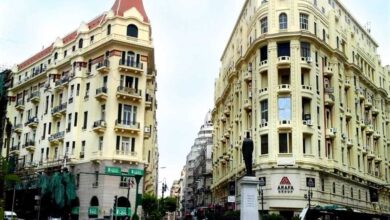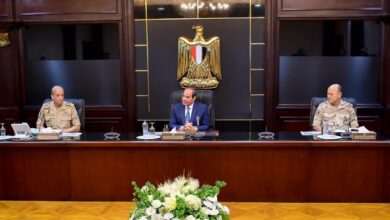
There are now not one, but four walls in downtown Cairo. Huge cubes of round-edged cement are clumsily stacked on top of each other, as if by a child. Hours after its construction, the Qasr al-Aini wall was almost completely covered in graffiti on the protesters’ side. Tens of silhouetted army soldiers stood sentry behind the cubes, visible through the gaps between them. Two young boys stood next to the wall and made obscene gestures at soldiers on the building behind the wall. Above them a young man clambered on top of the cubes and stretched out his arms to the side, fingers in a victory sign.
Around the corner the battle raged, with perhaps ten meters separating the two sides. The protesters’ front line was a wriggling mess of men and women in constant motion made up of three rows of stone throwers and spectators and people ferrying rocks to the front line. The flying missiles filled the sky like locusts. Protesters cheered and advanced at each security retreat, and were met with the sound of ammunition of some kind. False alarms of an army advance produced panicked surges back every so often. Old hands stood their ground in the middle and shouted "esbet, esbet"(stand your ground).
The army has been trying to find a successful formula to control public space for 10 months and has tried everything from threats of the law to attempts to co-opt political players to physical brutality and incitement of the general public against protesters. Nothing has worked. The protesters returned to Tahrir, and then to parliament. The threat of death and injury has not been enough to keep them away, and the army has resorted to this most crude of devices to control them, erecting monuments to its own failure.
It has adopted a similar approach in its dealings with that other public space, the media. On Saturday, gangs of soldiers raided flats and hotels overlooking Tahrir Square in order to confiscate and destroy the cameras filming the brutality below. It threw Al Jazeera’s equipment off a balcony. It wasn’t quite quick enough. The whole world has seen the image of the soldier stomping on the breasts of the prostrate woman in the blue bra while next to her six soldiers vigorously set upon a man like a pack of feral dogs.
There were other images, too — of a woman in her late fifties surrounded and hit, old men caught and bashed, bleeding children being dragged away by soldiers twice their size, photographs of a smiling Al-Azhar sheikh and a student of medicine, both shot and killed. In another universe this might constitute damning evidence but here, capturing the truth of something means holding truth hostage, making it disappear.
The Supreme Council of the Armed Forces (SCAF) employed Major General Adel Emara to do just that on Monday, assisted by Egyptian state media in yet another post-crisis press conference.
Emara, in a green beret, sat in front of journalists and delivered a soliloquy about plots to destabilize Egypt and genuine and non-genuine revolutionaries and the enormous pressure soldiers are under and the disaster of the books lost in the Insitut d’Egypte fire.
When Al Jazeera English journalist Nadia Abul Magd held up a copy of the front page of Al-Tahrir newspaper, featuring the now infamous photograph of a half-naked woman being attacked by soldiers, Emara instructed her to put it away. The SCAF general dealt with this incident by saying it was under “investigation” and told us that we must think about the circumstances in which it happened and the pressure soldiers are under. Just like that, one of the most shocking images of the last 10 months was dismissed with the prospect of a disciplinary procedure that will likely never happen.
Then Emara screened a video of the SCAF’s interpretation of recent events — the usual compilation of murky night shots and shaky mobile footage of youths hurling rocks and missiles at a target kept conveniently out of frame. This was interspersed with the “confessions” of various individuals including minors who had clearly been physically assaulted and seemed to have memorized a script.
Inevitably, there were echoes of Maspero as Emara delivered his performance and the journalists clapped (literally). Maspero, when even death was rewritten. There is a terrible absurdity in all this, not least of which is that as the atrocities get worse and the excuses more preposterous, public support for SCAF remains unchanged — there has been no significant public outcry over the latest scenes (outside of Tahrir Square and independent media), no mass rallying behind the call for an end to military rule.
State television’s Channel 1 had an interesting split screen on Saturday evening. On one side it was showing one of its insipid documentaries on Cairo, full of picturesque, tranquil shots of Nile and Islamic Cairo. This was juxtaposed against live shots of the battling on Qasr al-Aini.
When I first switched it on I thought they were making some kind of point: look what we’ve lost because of these Tahrir hooligans. In fact, it seems to be their version of coverage following the Maspero fallout (when they were viewed as accomplices to army murder): accept grudgingly that something is happening but don’t enquire.
But this strange split screen captures Egypt at the moment: Tahrir in a little box, the others, with their resentment and anxiety and yearning for stability in another. On my way to the funeral of Sheikh Emad Effat, killed outside parliament on Friday, the taxi driver said that protesters who died in recent events “can go to hell” — a stark condemnation given the taboo about speaking ill of the dead.
The taxi driver argued that the protesters “are not genuine revolutionaries.” Emara used the same tactic during his press conference. This has been the military’s strongest weapon. It has succeeded in dehumanizing protesters, making them unworthy of respect even in death while its soldiers are exculpated from the most inhuman of acts, again and again. Untouchable. Not all walls are visible.




